Striving to maintain physical fitness is a challenge, especially when circumstances prevent us from engaging in our usual exercise routines. In this article, we will explore various strategies and techniques to stay fit even when unable to engage in traditional forms of exercise.
From mindful eating and desk exercises to stress management and low-impact activities, there are numerous ways to prioritize our health and wellness, even when facing physical limitations. We will delve into the importance of maintaining overall fitness, as well as provide practical tips for incorporating healthy habits into daily life.
Maintaining fitness is crucial for our overall well-being, but it can be especially challenging when faced with limited mobility or busy schedules. However, by understanding the significance of staying fit and adopting alternative methods for physical activity, it is possible to achieve optimal health despite these obstacles. This article aims to provide guidance and encouragement for individuals seeking effective strategies to stay fit when traditional forms of exercise are not feasible.
By exploring the various facets of fitness including diet, movement, flexibility, stress management, sleep, and healthy habits, this article will equip readers with a comprehensive toolkit for achieving wellness even in challenging circumstances. Whether at home or in the office, these strategies can be easily implemented into daily routines for long-lasting health benefits How to Stay Fit When You Can’t Exercise encompasses a holistic approach to maintaining physical fitness and promoting a healthy lifestyle.
Mindful Eating
Eating a healthy diet is essential for staying fit, especially when you can’t exercise. Mindful eating is a practice that involves paying attention to the food you eat and being present in the moment while consuming it. This can help you maintain a healthy weight, reduce overeating, and make better food choices.
One tip for mindful eating is to listen to your body’s hunger and fullness cues. Eat when you are hungry and stop when you are satisfied, rather than eating out of boredom or emotion. Another tip is to choose nutrient-dense foods such as fruits, vegetables, lean proteins, and whole grains. These foods provide essential vitamins and minerals that support overall health.
It’s also important to minimize distractions while eating, such as watching TV or scrolling through your phone. Engaging in conversation with family or friends during meal times can help slow down your eating pace and prevent overeating.
Additionally, practicing gratitude for the food you have can help foster a positive relationship with eating and promote mindful choices. By following these tips for mindful eating, you can maintain a healthy diet and stay fit even when you can’t engage in regular exercise.
| Mindful Eating Tips | Benefits |
|---|---|
| Listen to your body’s hunger and fullness cues. | Helps prevent overeating and make better food choices. |
| Choose nutrient-dense foods. | Provides essential vitamins and minerals for overall health. |
| Minimize distractions while eating. | Prevents overeating and fosters a positive relationship with food. |
Desk Exercises
When you find yourself in a situation where you can’t engage in traditional forms of exercise, it’s important to explore alternative ways to stay active and maintain your fitness. Desk exercises are an excellent way to keep your body moving, especially if you have a sedentary job or lifestyle.
These simple workouts can be done right at your desk, making them convenient for those who are unable to go to the gym or engage in more vigorous physical activity.
One effective desk exercise is the seated leg raise, which helps strengthen your abdominal muscles and improve circulation in your legs. Another easy workout is shoulder shrugs, which can alleviate tension and stiffness in your neck and shoulders. Additionally, you can do chair squats to work on your lower body strength, even while sitting at your desk. By incorporating these exercises into your daily routine, you can combat the negative effects of prolonged sitting and promote better overall health.
Incorporating desk exercises into your daily routine can make a significant difference in how you feel physically and mentally. Not only does it help combat the negative impact of sitting for long periods, but it also boosts energy levels and improves focus.
It’s essential to take short breaks throughout the day to perform these exercises, as they can contribute to your overall well-being, even if traditional forms of exercise are not currently accessible. Remember, every little bit of movement counts towards staying fit when you can’t exercise in the usual way.
| Exercise | Benefits |
|---|---|
| Seated Leg Raise | Strengthens abdominal muscles; improves leg circulation |
| Shoulder Shrugs | Alleviates tension and stiffness in neck and shoulders |
| Chair Squats | Works on lower body strength; helps combat effects of prolonged sitting |
Stretching and Flexibility
Importance of Stretching and Flexibility
Stretching and flexibility exercises are essential components of any fitness routine, even for those who can’t engage in vigorous physical activity. These techniques help improve mobility, reduce the risk of injury, and enhance overall well-being. When you can’t exercise, focusing on stretching and flexibility can be a great way to maintain your physical health.
Techniques to Improve Flexibility
There are various techniques that can help improve flexibility without engaging in strenuous exercise. These include static stretching, dynamic stretching, and proprioceptive neuromuscular facilitation (PNF) stretching. Incorporating these techniques into your daily routine can help keep your muscles supple and improve your range of motion.
Mobility Exercises for Everyday Life
In addition to traditional stretching techniques, incorporating mobility exercises into your daily activities can help maintain flexibility. Simple movements such as neck rotations, ankle circles, hip flexor stretches, and shoulder rolls can be performed throughout the day, whether you are at home or in the office. These exercises can help combat the negative effects of prolonged sitting and promote better posture.
By focusing on stretching and flexibility when you can’t exercise, you can still actively contribute to your overall fitness and well-being. Incorporating these techniques into your daily routine will not only help maintain physical health but also promote mental clarity and a sense of general wellness despite any limitations on rigorous physical activity.
Stress Management
In today’s fast-paced world, stress and anxiety are common experiences that can have a significant impact on our overall health. When you are unable to engage in regular exercise, managing stress becomes even more important for maintaining your well-being. Here are some effective strategies for reducing stress and anxiety through meditation and relaxation techniques:
1. Mindful Breathing: One of the simplest yet most effective ways to reduce stress is through mindful breathing. Taking deep, slow breaths while focusing on the sensation of air entering and leaving your body can help calm your mind and relax your muscles.
2. Guided Imagery: Visualization techniques can be powerful tools for reducing stress. Find a quiet place, close your eyes, and imagine yourself in a peaceful, serene environment. Whether it’s a quiet beach or a tranquil forest, visualizing these calming scenes can help alleviate feelings of stress and anxiety.
3. Progressive Muscle Relaxation: This technique involves tensing and then relaxing different muscle groups in the body. By systematically working through each muscle group, you can release tension and promote a sense of physical relaxation.
Incorporating these relaxation techniques into your daily routine can help you better manage stress when exercise isn’t an option. By making time for mindfulness and relaxation, you can support your overall well-being even during periods when physical activity may be limited.
Low-Impact Activities
Exploring Low-Impact Activities
When it comes to staying fit without strenuous exercise, low-impact activities can be a great alternative. Activities such as swimming, Pilates, or yoga are excellent options for individuals who may have physical limitations or injuries that prevent them from engaging in high-impact workouts. These activities not only help improve physical fitness but also provide mental clarity and relaxation.
Benefits of Swimming
Swimming is a full-body workout that is gentle on the joints, making it an ideal exercise for those with physical limitations. It helps to improve cardiovascular health, build muscle strength, and increase flexibility. Additionally, swimming can also help reduce stress and anxiety while promoting overall well-being.
Practicing Pilates and Yoga
Pilates and yoga are both low-impact exercises that focus on strength, flexibility, and breath control. These activities can be modified to accommodate different fitness levels and physical abilities, making them accessible to a wide range of individuals. Both Pilates and yoga emphasize mindfulness, which can contribute to reducing stress and improving mental health.
Engaging in these low-impact activities not only helps individuals stay fit when they can’t engage in traditional exercise but also offers a holistic approach to wellness that incorporates both physical and mental well-being. By incorporating these activities into their routine, individuals can maintain their fitness levels while also reaping the benefits of reduced stress and improved overall health.
Proper Sleep
It’s no secret that getting proper sleep is essential for overall health and fitness. When you can’t exercise, ensuring that you get enough rest becomes even more crucial in maintaining your well-being. Here are some strategies to help you focus on the role of rest and recovery in staying fit when exercise isn’t an option:
1. Establish a regular sleep schedule: Setting a consistent bedtime and wake-up time can help regulate your body’s internal clock, leading to better quality sleep. Try to stick to this schedule even on weekends to maintain a healthy sleep routine.
2. Create a relaxing bedtime routine: Engage in calming activities before bed, such as reading, taking a warm bath, or practicing relaxation techniques like deep breathing or meditation. Avoiding screens and electronic devices at least an hour before bed can also contribute to better sleep.
3. Prioritize comfort and environment: Make sure your bedroom is conducive to good sleep by keeping it cool, dark, and quiet. Investing in a comfortable mattress and pillows can also greatly improve the quality of your sleep.
By focusing on these strategies, you can prioritize rest and recovery as part of your overall health and fitness plan, even when traditional exercise is not an option. Remember that adequate sleep not only impacts physical health but also mental clarity and emotional well-being.
Healthy Habits
Establishing daily routines and habits that promote wellness and mental clarity is essential for staying fit, especially when traditional exercise may not be an option. One key aspect of maintaining a healthy lifestyle is to prioritize regular sleep. Ensuring that you get enough rest each night can have a significant impact on your overall health and well-being. Aim for 7-9 hours of quality sleep each night to allow your body to recover and recharge.
Additionally, practicing mindfulness and incorporating stress-reducing activities into your daily routine can help promote mental clarity and emotional well-being. Whether it’s through meditation, deep breathing exercises, or simply taking a few moments of quiet reflection, finding ways to manage stress can contribute to a sense of balance and overall fitness.
Incorporating physical activity into your daily habits, even in small ways, can also contribute to staying fit without traditional exercise. This can include taking the stairs instead of the elevator, going for short walks during breaks at work, or engaging in household chores that require movement. These simple activities can add up throughout the day and contribute to overall physical fitness.
Overall, healthy habits are crucial for staying fit when you can’t exercise in the typical sense. By focusing on proper rest, stress management, and incorporating physical activity into daily routines, individuals can maintain their well-being even when facing limitations on traditional exercise options.
Conclusion
In conclusion, staying fit and healthy when you can’t exercise is definitely possible with the right strategies and mindset. While physical activity is important for maintaining overall health, there are other ways to keep your body active and maintain fitness even without traditional exercise. By focusing on mindful eating, engaging in low-impact activities, managing stress, getting proper sleep, and practicing flexibility techniques, you can still achieve great results in your health and wellness journey.
It’s important to remember that taking care of your body goes beyond just physical activities. A healthy diet, stress management, adequate rest, and daily habits all play a crucial role in overall well-being. By incorporating these strategies into your daily routine, you can maintain a healthy lifestyle even when traditional exercise isn’t an option.
So next time you find yourself in a situation where you can’t exercise as usual, remember that there are still plenty of other ways to take care of your body and stay fit. With the right approach and commitment to a healthy lifestyle, you can continue to prioritize your health and wellness no matter what challenges come your way.
Frequently Asked Questions
How Do You Stay Fit if You Can’t Exercise Easily?
Staying fit without exercising can be challenging, but it’s not impossible. Focus on maintaining a healthy diet, practicing good posture and stretching regularly, and incorporating small movements into your daily routine.
Is It Possible to Stay Fit Without Exercise?
It is possible to stay fit without exercise by prioritizing physical activity in other forms. This could include taking the stairs instead of the elevator, doing chores around the house, or engaging in low-impact activities like walking or swimming.
How Do You Cope When You Can’t Exercise?
Coping when you can’t exercise may involve adjusting your mindset and finding alternative ways to stay active. This might include seeking support from a healthcare professional, exploring different types of physical therapy, or focusing on relaxation techniques to manage stress and anxiety associated with not being able to exercise.

Passionate about providing useful information to anyone with an interest in the field of Personal Training, I strive to pass on to our readers quality information and to answer any questions about Personal Trainers, the work they do and how to become one.





